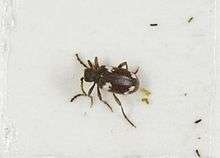Ptinus sexpunctatus
| Ptinus sexpunctatus | |
|---|---|
 | |
| Ptinus Sexpunctatus caught on a sticky blunder trap in the Yorkshire Museum | |
| Scientific classification | |
| Kingdom: | Animalia |
| Phylum: | Arthropoda |
| Class: | Insecta |
| Order: | Coleoptera |
| Infraorder: | Bostrichiformia |
| Superfamily: | Bostrichoidea |
| Family: | Anobiidae |
| Genus: | Ptinus |
| Subgenus: | Ptinus (Gynopterus) |
| Species: | P. sexpunctatus |
| Binomial name | |
| Ptinus sexpunctatus Panzer, 1789 | |
Ptinus sexpunctatus is a species of beetles in the genus Ptinus of the family Anobiidae.[1] It is commonly known as the six-spotted spider beetle.

Taxonomy
P. sexpunctatus is one of eleven species of Ptinid in the subgenus Gynopterus. The subgenus was first described by Mulsant and Rey in 1868.[2]
Description
The species is approximately 4–5 mm in length and is a uniform dark colouration. It has very prominent basal and apical patches of appressed white scale. The grooves on the elytra are very deep. [3]
Distribution and Habitat
Ptinus sexpunctatus is a Palearctic spider beetle (Anobiidae: Ptininae) found throughout Europe.[1] In the United Kingdom it is categorised as 'Nationally Notable B' by the National Biodiversity Network and thus appears in between 31-100 hectads (10 km grid squares) across the country.[4] In 2007 it was first recorded as an invasive species in North America where it may have imported with introductions of Osmia cornuta and Osmia cornifrons.[1]
The six-spotted spider beetle has been generally associated with pine forests,[5] although more cosmopolitan sightings have occurred indoors.[6][7][8] The larvae of P. sexpunctatus are commensals in the nests of cavity-nesting solitary bees in the genera Osmia and Megachile.[1] One example has been recorded, from Nova Scotia, Canada, in the nest of the Blue Orchid Mason Bee (Osmia lignaria).[3] Within the nest, the larvae feed on the food provisions of the host larva.
External links
- High resolution images of P. sexpunctatus morphology
- Ptinus sexpunctatus at Encyclopedia of Life
- Bibliography for Ptinus sexpunctatus Panzer, 1795 at Biodiversity Heritage Library
References
- 1 2 3 4 Majka, C.G., Philips, T.K., and Sheffield, C. 2007. "Ptinus sexpunctatus Panzer (Coleoptera: Anobiidae, Ptininae) recently recorded in North America", Entomological News 118 (1), 73-77.
- ↑ Mulsant, E.; Rey, C. (1868). Histoire Naturelle des Coléoptères de France. Deyrolle.
- 1 2 Majka, C. (2004). "Ptinus sexpunctatus Panzer". Retrieved 2015-08-10.
- ↑ National Diversity Network (2015). "Ptinus sexpunctatus Panzer, 1792". Natural History Museum. Retrieved 2015-08-10.
- ↑ Franc, N (2007). "Observationer av nästtjuvbaggen, Ptinus sexpunctatus, Panzer 1795" (PDF). Entomologisk tidskrift. Retrieved 2015-08-08.
- ↑ Smith, K.G. (1995). "Ptinus sexpunctatus Panz: (Col. Ptinidae) indoors in North London (Middlesex)". Entomologist's Monthly Magazine. 131: 105.
- ↑ Jones, R.A. (1996). "Ptinus sexpunctatus Panz. (Col. Ptinidae) indoors in south London (Surrey)". Entomologist's Monthly Magazine. 132: 304.
- ↑ Parker, A. (2015). "Ptinus sexpunctatus in the Yorkshire Museum". Bulletin of the Amateur Entomologists' Society. 74: 180–181.